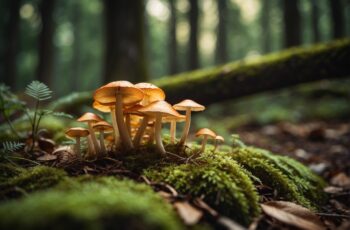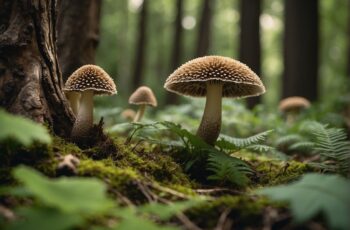Kentucky’s diverse ecosystems make it a treasure trove for mushroom enthusiasts like yourself. From the rolling hills to dense woodlands, you’ll find a wide array of fungi species thriving. Whether you’re a seasoned forager or simply curious about the fungal kingdom, Kentucky forests and fields are a fertile hunting ground for a variety of mushrooms, ranging from the sought-after morels in spring to the sturdy, shelf-like chicken of the woods.
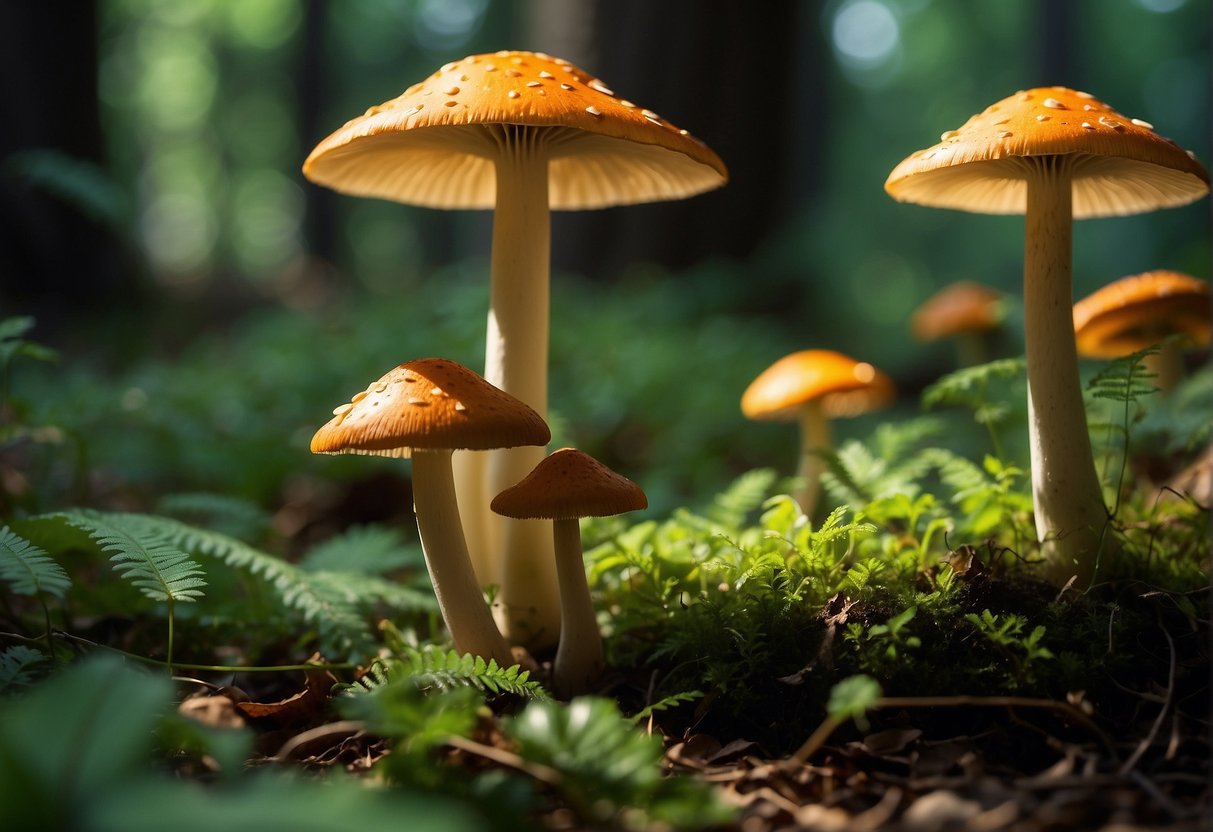
It’s important to know what you’re looking for when venturing into the woods. Each mushroom species has unique characteristics, and understanding these is essential for safe foraging. For example, the edible and highly prized morels are distinctive with their honeycomb caps, but there are false morels which can be toxic and therefore must be avoided. Educating yourself on these differences ensures your foraging experience is not only enjoyable but also safe.
Mushrooms aren’t just fascinating to forage; they play a crucial role in Kentucky’s ecosystems as decomposers. They break down organic material, enriching the soil—an unseen yet critical process supporting other plant and animal life. So next time you’re walking through the woods, remember that these fungi are not only a potential delicious find but also key players in the cycle of life in the wilds of Kentucky.
Classification and Morphology of Kentucky Mushrooms
In Kentucky, the classification and morphology of mushrooms reveal a rich fungal biodiversity. From the rolling hills to dense forests, you’ll find a variety of mushrooms with distinct features, including various caps, gills, and spore prints that aid in identification.
Identifying Features
- Cap: Pay attention to the shape, color, and texture. Morels, for instance, have a honeycombed cap with ridges and pits, while chanterelles boast a distinctive wavy margin and can range from yellow to deep orange.
- Gills/Pores: These structures on the underside of the cap can be key identifiers. Oyster mushrooms have a decurrent gill pattern running down the stem, whereas morels lack true gills, presenting a sponge-like appearance.
- Stem (Stipe): Examine the stem’s length, thickness, and whether it has a bulbous base or a ring.
- Spore Print: The color of the spore print, ranging from creamy to dark brown, can help differentiate between species. Morels produce a creamy yellow spore print, providing a contrast to the darker spore prints of some other fungi.
- Size and Color: These can vary widely, even within species due to environmental factors.
Mycelium and Spores
- Mycelium: This is the vegetative part of a fungus, consisting of a network of fine white filaments (hyphae) that absorb nutrients. It’s often hidden below the surface of wood or soil, and in healthy forests, it plays a vital role in nutrient cycles.
- Spores: The reproductive cells allowing fungi to spread and are usually released in large quantities. Morels and oyster mushrooms release spores from their gills or pores when mature, with spore color being a useful trait in identification.
By understanding these characteristics, you’ll become more adept at navigating Kentucky’s fungal landscape, uncovering the hidden world of mushrooms right under your feet.
Foraging and Edible Mushrooms in Kentucky
Kentucky’s woodlands offer a cornucopia of edible mushrooms, with each season bringing its own array of fungi. As you prepare to forage, remember that the correct identification is crucial for safety, and the culinary uses of your finds are as varied as the mushrooms themselves.
Seasonal Guide to Foraging
In Kentucky, the fall is prime time for mushroom hunting, especially for the sought-after morel mushrooms and the distinctive chanterelles, which have a rich and earthy flavor. During the summer, you can often spot the bright yellow and orange colors of the chanterelle, or the distinctive oyster mushrooms growing on old oak logs. To plan your foraging expedition, consider these seasonal markers:
- Spring: Morels typically kick off the season.
- Summer: Look for oyster and chanterelle mushrooms.
- Fall: A diverse variety of edible mushrooms peaks.
Safety and Mushroom Identification
Mushroom identification is a skill that requires experience and knowledge. Confusing edible mushrooms with toxic lookalikes can lead to illness or worse. Always look for clear indicators, such as spore prints, cap shapes, and attachment to the host tree. Certain mushrooms, like the Velvet Foot with its unique orange cap, offer a safer bet for beginners because of their few lookalikes. Keep in mind:
- Never taste or eat mushrooms unless you are 100% sure of their identity.
- If you’re a novice, consider joining a local foraging group or enlisting the help of an experienced forager.
Culinary Uses and Recipes
Edible mushrooms collected in Kentucky add incredible flavors and textures to your meals. Morels are coveted for their nutty taste, and they’re superb when sautéed in butter. Chanterelles can elevate a simple pasta dish with their earthy flavor and slight peppery bite. For the adventurous home cook, here are a few ways to bring these forest treasures to your table:
- Sautéed Chanterelles: Quick and easy, bringing out their natural taste.
- Morel Mushroom Risotto: A classic that showcases morels’ rich flavors.
- Oyster Mushroom Tacos: A vegetarian delight with a meaty texture.
Remember that when foraged responsibly, Kentucky’s edible mushrooms offer both a delightful outdoor activity and a tasty reward for your efforts.
Mushroom Habitats and Ecosystems
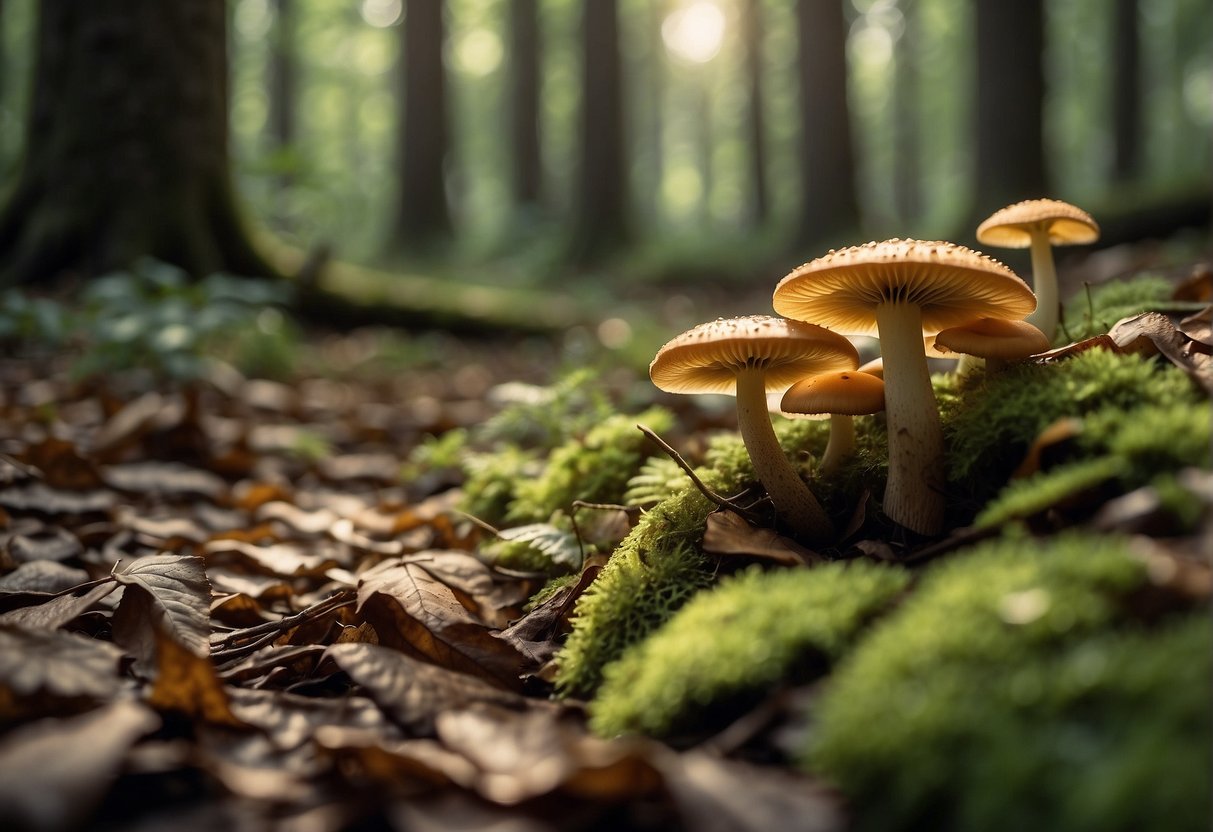
Mushrooms thrive in environments where a balance of moisture and organic matter provides the nourishment they require. In Kentucky, you’ll discover a diverse range of mushrooms populating various habitats, shaped by the interaction with local flora and climate conditions.
Mushroom-Growing Regions
Kentucky’s forests are a vibrant sanctuary for mushrooms, thanks to the state’s ample rainfall and abundant greenery. In North America, mushrooms are commonly found in both broadleaf and coniferous forests, but in Kentucky, you’ll often spot them in deciduous woodlands, rich with oaks and beech trees. These areas provide a consistent supply of fallen leaves and rotting wood, essential for the growth of fungi. It’s important for you as a forager to recognize that habitats with a mixture of tree species, especially those with a high density of oaks and beech, are prime mushroom territory.
Trees and Organic Matter
Mushrooms form a crucial part of the forest’s ecosystem by breaking down organic matter. The decomposition process they facilitate is vital for recycling nutrients back into the soil, promoting forest health. You’ll find that areas with a significant presence of conifer trees, as well as hardwoods, support a variety of fungal species. Each tree type hosts specific mushrooms; for instance, the oaks of Kentucky are frequently associated with prized edible species, while beech trees often harbor particular fungi that prefer their bark and fallen leaves for sustenance. When you’re exploring the woods, keep an eye out for the decomposing logs and leaf litter—they are hotspots for mushroom growth.
Conservation and Community Involvement
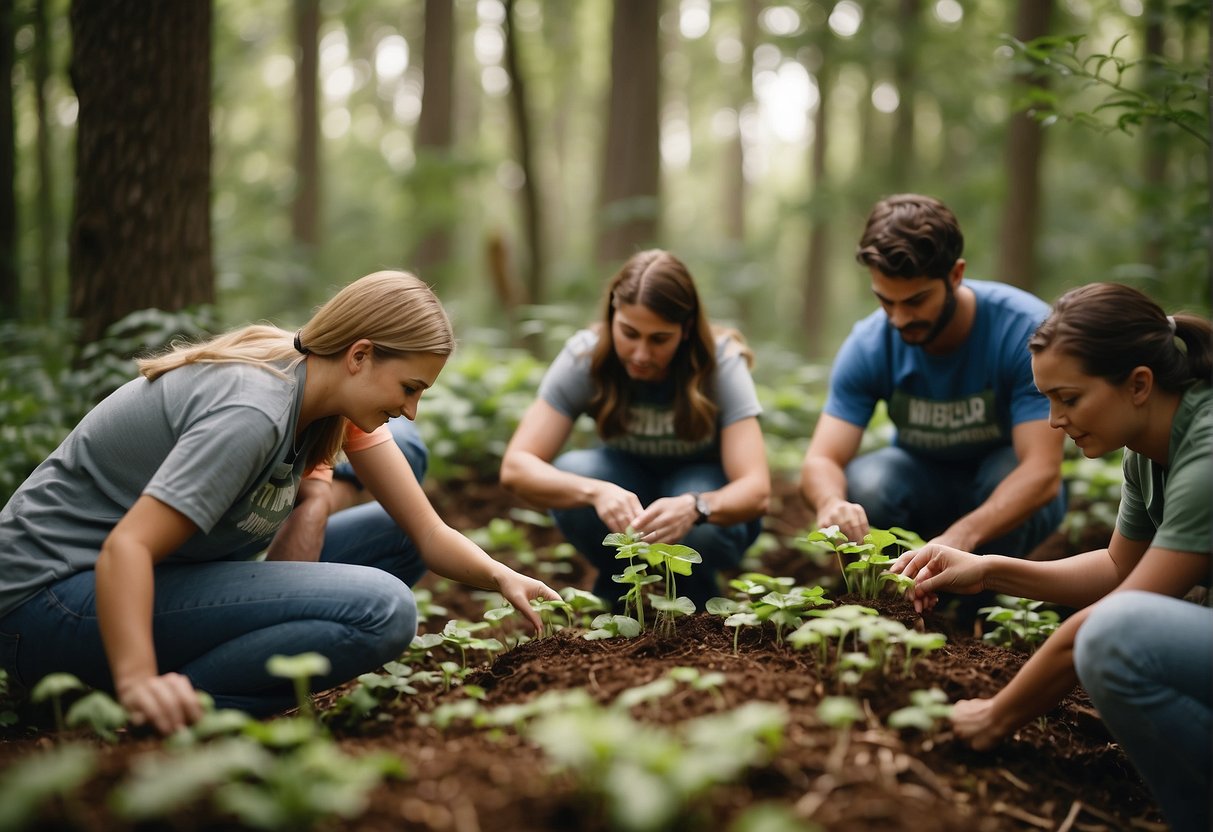
In Kentucky, the lush woodlands offer a fertile ground for mushroom enthusiasts to engage in sustainable foraging while supporting conservation efforts. By participating in community workshops and social groups, you play a vital role in preserving Kentucky’s rich mycological heritage.
Sustainability and Mushroom Hunting
When you head out to hunt for mushrooms in Kentucky, it’s crucial to practice sustainability. This means understanding the ecological impact of your foraging. Always harvest responsibly by:
- Taking only what you need to ensure mushrooms can continue to flourish.
- Being careful not to disturb the surrounding habitat.
Kentucky’s forests are a treasure trove of biodiversity, and your actions can help maintain this balance.
Workshops and Social Groups
Joining a workshop or social group, such as those found on Facebook, can greatly enhance your mushroom hunting experience. These groups often offer:
- Educational workshops on identifying native fungi.
- Opportunities to connect with fellow mushroom enthusiasts.
Active participation in these groups helps foster a sense of community and promotes ongoing conservation efforts. You’re not just collecting mushrooms; you’re contributing to a legacy of environmental stewardship.

